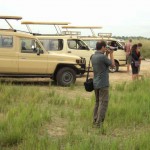
Do you know that many people understate chimpanzee trekking while flourishing about gorillas? Oops, one ought to know what he or she is missing out if he or she came to travel to Uganda without taking a visit to see chimpanzees.
Well, let’s first give you an insight about chimpanzees. These primates share about 98% of human genes, they are very social and caring most especially for their off springs. In their natural habitats, it is so interesting to watch these creatures play. They like spending most of their time in trees because this would be a suitable ground for them to swing all day long. On the ground, they usually move on their four legs although they are also able to move on the two behind legs. Chimps have a life span of about 40 years while those in captivity can stay for over 60 years. An effort has been undertaken to conserve these species and this has seen an increase in their numbers over centuries. They majorly feed on leaves, fruit flowers and seeds.
As earlier stated, chimpanzee trekking is less sought of yet it is one of the most incredible experiences one can encounter during a safari to any destination that hosts these living creatures. It involves searching for a habituated chimpanzee group and observing it for one hour. In Uganda, a good number of travel destinations host these endangered creatures. Although Kibale forest national park is the most popular chimp destination whose trekking commences at Kanyanchu visitor center, other areas such as Kyambura gorge and Maramagambo forest in Queen Elizabeth national park, Budongo forest in Murchison falls national park, Semuliki national park also host these primates. Some areas such as the Uganda Wildlife Education Center (UWEC), formerly known as the zoo and Ngamba island chimpanzee sanctuary also hold a good number of captivated chimps. Since they are so mobile, chances to see man’s closest relatives is uncertain but when it comes to Kibale forest national park, the chance is guaranteed as the park hosts a large amount of them. Rwanda is another destination known for hosting these exceptional creatures most especially in Nyungwe forest national park. Note that trekking can take place in the morning and afternoon for example in Kibale, it starts at 8am and 2pm.
Please note that Chimpanzee trekking is different from chimpanzee habituation. Habituation involves getting wild chimps familiar to the presence of humans in that they can continue with their daily routines in their natural habitats. Here, you will be accompanied by experienced researchers who will take you through this experience and this usually takes longer than trekking. The price of a chimp habituation permit goes for 220 USD compared to the 150 USD and this is done in only Kibale forest national park which has one family undergoing this process. Both activities are fun and we encourage travelers to participate and experience each of them.
About families
Kibale forest national park has two habituated chimp families while Budongo forest has a good number of wild chimpanzees although the habituated ones are found in the Kaniyo Pabidi section.
Cost of chimpanzee trekking
The price of this awesome activity varies from the area in which you intend to do trekking. One has to obtain a permit if he or she intends to track chimps in Kibale national park and this goes for 150 USD per person acquired at Uganda Wildlife Authority (UWA). This permits you to stay with these gentle wild creatures for one hour as well as watching plant life, other primates such as Vervet monkeys, olive baboons, red colobus monkeys and birds. Please make sure that you book this permit in time, most preferably a few months earlier to avoid disruptions. A chimp permit to Budongo forest costs 80 USD per person and the major section in which this activity is carried out in this forest is known as Kaniyo Pabidi. A permit in Kyambura gorge in Queen Elizabeth goes for 50 USD per person.
Best time for trekking
The activity can be done all year round although the best time is the dry season between months of June to September and December to January because the trails are drier and easily passable compared to the wets months.
What to pack and carry
Please carry trekking boots, insect repellent, long sleeved shirts, trousers, a back pack, a walking stick to help you during the entire experience. These materials will protect you from getting scratches and moving around the difficult trails with much ease. Please ensure to carry cameras with non flash photographs so that you can take pictures for memories. Carry sun huts and glasses during hot weather and sweaters, rain jackets during the cold weather.
Chimp trekking has got do’s and don’ts. These include
- The activity is limited to a maximum of 6 people.
- Keeping a distance of about 6-8 meters to avoid them from catching any disease
- People with communicable diseases such as diahorea, cough and flu are not allowed to trek
- Eating, drinking and smoking in their presence is prohibited
- The minimum age for trekking is 15 years of age
- Only cameras that can take non flash photos are allowed
- Avoid dirtying the chimp habitats because this may lead to destructions
- Do not act rough when a chimp approaches you, rather be submissive
- Avoid sneezing in front of them
- Make sure that you minimize your movements in their presence
- Ensure that your voices are low
- Keep in your groups in order to give them ample space
If you really intend to enjoy this experience, make sure that you pay attention and in this way, you will be hitting two birds with one stone because not only will you be able to view chimps, but also other primates and plant life.
Accommodation
When it comes to accommodation, a number of lodges are present all around the chimp destinations. Please feel free to book a lodge of your own preference using the internet or contact your trusted tour operator so that they can help you with this option.

 Posted in
Posted in 

